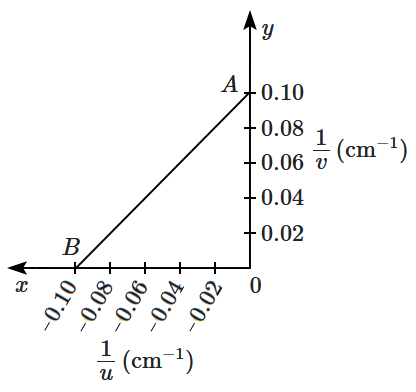Select Question Set:
An object is placed \(30~\text{cm}\) in front of a convex spherical mirror with a radius of curvature of \(40~\text{cm}.\) The position of the image formed is:

1.
\(60~\text{cm}\)
2.
\(-60~\text{cm}\)
3.
\(12~\text{cm}\)
4.
\(-12~\text{cm}\)
Subtopic: Reflection at Spherical Surface |
65%
Level 2: 60%+
Please attempt this question first.
Hints
Please attempt this question first.
During a cloudy day, a primary and a secondary rainbow may be created. Which of the following statement is correct?
| 1. | primary rainbow is due to double internal reflection and is formed above the secondary one. |
| 2. | primary rainbow is due to double internal reflection and is formed below the secondary one. |
| 3. | secondary rainbow is due to double internal reflection and is formed above the primary one. |
| 4. | secondary rainbow is due to a single internal reflection and is formed above the primary one. |
Subtopic: Total Internal Reflection |
68%
Level 2: 60%+
NEET - 2022
Hints
An observer is using an astronomical refracting telescope to observe planets in normal adjustment. The focal lengths of the objective and eyepiece used in the telescope construction are \(20\text{m}\) and \(2\text{cm}\) respectively. Consider the following statements about the telescope:
The correct statements are:
| (A) | the distance between the objective and the eyepiece is \(20.02\text{m}.\) |
| (B) | the magnification of the telescope is \(-1000\). |
| (C) | the image of the planet is erect and diminished. |
| (D) | the aperture of the eyepiece is smaller than that of the objective. |
The correct statements are:
| 1. | A, B, and C | 2. | B, C, and D |
| 3. | C, D, and A | 4. | A, B, and D |
Subtopic: Telescope |
68%
Level 2: 60%+
NEET - 2022
Hints
The power of a lens (biconvex) is \(1.25~\text{m}^{-1}\) in a particular medium. The refractive index of the lens is \(1.5\) and the radii of curvature are \(20\) cm and \(40\) cm respectively. The refractive index of the surrounding medium is:
| 1. | \(1\) | 2. | \(\dfrac 97\) |
| 3. | \(\dfrac 3 2\) | 4. | \(\dfrac 4 3\) |
Subtopic: Lens Makers' Formula |
55%
Level 3: 35%-60%
Please attempt this question first.
Hints
Please attempt this question first.
The reddish appearance of the sun at sunrise and sunset is due to:
| 1. | the scattering of light. |
| 2. | the polarisation of light. |
| 3. | the colour of the sun. |
| 4. | the colour of the sky. |
Subtopic: Total Internal Reflection |
89%
Level 1: 80%+
NEET - 2013
Hints
Two plane mirrors are inclined at \(70^\circ.\) A ray incident on one mirror at an angle \(\theta\) after reflection falls on the second mirror and is reflected from there parallel to the first mirror. The value of \(\theta\) is:
1. \(45^\circ\)
2. \(30^\circ\)
3. \(55^\circ\)
4. \(50^\circ\)
1. \(45^\circ\)
2. \(30^\circ\)
3. \(55^\circ\)
4. \(50^\circ\)
Subtopic: Reflection at Plane Surface |
54%
Level 3: 35%-60%
NEET - 2013
Hints
The graph between \(\dfrac1u\) and \(\dfrac1v\) for a thin convex lens in order to determine its focal length is plotted as shown in the figure. The refractive index of the lens is \(1.5\) and both surfaces have the same radius of curvature \(R.\) The value of \(R\) is: (where \(u\) \(=\) object distance, \(v\) \(=\) image distance)


| 1. | \(10~\text{cm}\) | 2. | \(20~\text{cm}\) |
| 3. | \(30~\text{cm}\) | 4. | \(40~\text{cm}\) |
Subtopic: Lens Makers' Formula |
66%
Level 2: 60%+
Please attempt this question first.
Hints
Please attempt this question first.
As light traverses through an optical medium, it is observed that its wavelength decreases.
| Statement I: | In this case, the frequency of light increases. |
| Statement II: | In the above case, the refractive index of the medium increases. |
| 1. | Statement I is incorrect and Statement II is correct. |
| 2. | Both Statement I and Statement II are correct. |
| 3. | Both Statement I and Statement II are incorrect. |
| 4. | Statement I is correct and Statement II is incorrect. |
Subtopic: Refraction at Plane Surface |
65%
Level 2: 60%+
Hints
An air bubble in a glass slab \((\mu=1.5) \) is \(5\) cm deep when viewed from one face and \(2\) cm deep when viewed from the opposite face. The thickness of the slab is:
1. \(10\) cm
2. \(7.5\) cm
3. \(10.5\) cm
4. \(7\) cm
1. \(10\) cm
2. \(7.5\) cm
3. \(10.5\) cm
4. \(7\) cm
Subtopic: Refraction at Plane Surface |
81%
Level 1: 80%+
Please attempt this question first.
Hints
Please attempt this question first.
If the angle of the prism is \(60^\circ\) and the angle of minimum deviation is \(40^\circ,\) the angle of refraction will be:
1. \(30^\circ\)
2. \(60^\circ\)
3. \(100^\circ\)
4. \(120^\circ\)
1. \(30^\circ\)
2. \(60^\circ\)
3. \(100^\circ\)
4. \(120^\circ\)
Subtopic: Prisms |
73%
Level 2: 60%+
Please attempt this question first.
Hints
Please attempt this question first.
Select Question Set:






